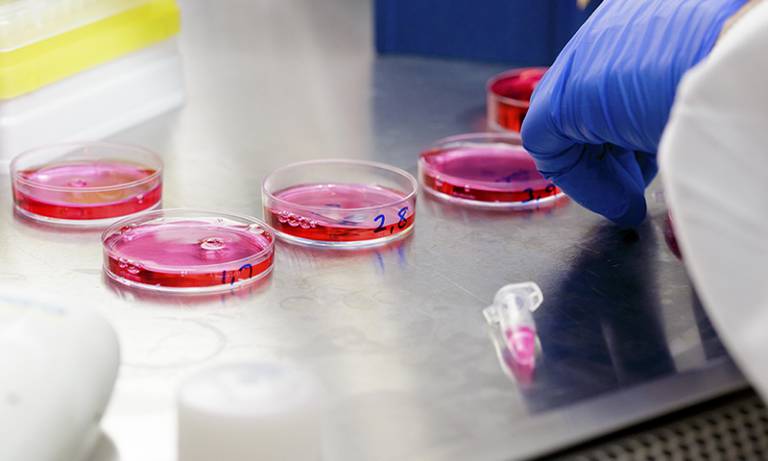Developmental susceptibility to childhood leukaemia uncovered
14 April 2018
Researchers have discovered that the commonest type of childhood acute leukaemia may start in the early foetus as a result of a developmental susceptibility in developing immune cells.

The discovery, coupled with the research team’s successful development of a human induced pluripotent stem cell (hiPSC) model to analyse human foetal B cells, sheds light on how childhood B cell acute lymphoblastic leukaemia (B-ALL) may start by disrupting normal development and provides a new platform for testing innovative drug strategies in childhood leukaemia.
The idea that childhood leukaemia originates in the blood cells of the developing foetus is supported by previous research showing that many children have leukaemia-associated mutations in their blood cells detectable at birth. In this case, the study team focused on one blood cell mutation in particular - ETV6-RUNX1 - the commonest genetic driver of childhood B-ALL. Children who have this mutation have an asymptomatic pre-leukaemia, but a proportion of them progress to acute leukaemia, usually before the age of 10 years old. Despite being the commonest cause of leukaemia in children, this disorder is barely seen in adults, raising the prospect that ETV6-RUNX1 specifically affects the immune cells of the developing foetus.
“To explore this idea that there is a susceptible cell type in a developing human embryo, we approached the study from two different angles,” explains Dr Simon Richardson, joint first author and Clinical Lecturer in Haematology. “Firstly, my colleague, Dr Charlotta Böiers (joint first author; INCA Fellow) was working with foetal blood examining the earliest developing B cells and found a blood progenitor cell that could readily make B cells. This progenitor cell had an unusual property, in that it switches between making different types of immune cells during early foetal development - first we saw it make myeloid cells (such as macrophages) and then over time it switched to B cells (lymphoid cells that make antibodies). At a very defined stage of development these foetal progenitors can actually make both types of immune cell. This is a unique developmental process that’s happening in the foetus as the developing immune system starts to make more complex cell types.”
“The second part of the project was my work on modelling how ETV6-RUNX1 sets up a pre-leukaemia. Extensive research has been done to try and model ETV6-RUNX1 B-ALL in model organisms and cells lines, but often the results don’t match the disease phenotype we see in children. One possible reason for this was that these models weren’t taking account of the human developmental biology that Charlotta had uncovered. Working with human foetal blood is technically very challenging, so we tested whether turning human embryonic stem cells or iPSCs, which can be derived from adult tissues such as skin, into B cells in the lab would recreate what we had seen in the foetus. We were amazed by the degree of similarity, in particular that the pluripotent stem cell cultures also underwent the switch from myeloid to lymphoid that we had discovered in the foetus.”
“We wanted to see how ETV6-RUNX1 started pre-leukaemia in developing human foetal blood cells, so we used CRISPR-Cas9 gene editing to create a human iPSC model of ETV6-RUNX1 B-ALL.” Using the iPSC model, the researchers were able to show that the ETV6-RUNX1 mutation specifically stalled the development of foetal B cell progenitors resulting in pre-leukaemic immune cells that mimicked many of the key features seen in childhood ALL. Importantly, the stalled pre-leukaemic B cells showed significant myeloid programming and potential, indicating that ETV6-RUNX1 specifically subverts the unique programming seen in foetal B cell progenitors, whilst simultaneously activating the DNA cutting enzyme RAG, that is thought to cause many of the mutations that drive progression to acute leukaemia. “Thanks to this cross comparison, we now know that we can model the earliest emerging B cells in the human foetus using pluripotent stem cells,” says Dr Richardson. “That’s really important given that these are the likely cells in which childhood leukaemia starts. This stem cell model enables an experiment to be repeated over and over again in a controlled way, plus you can alter the genetics to see how this affects disease progression or use this system for drug screening.”
This research has been supported by Cancer Research UK, Wellcome Trust, NIHR, Crafoord Foundation, Swedish Childhood Cancer Foundation, Swedish Cancer Society, Hemato-Linné Grant,Tobias Foundation, Children with Cancer and Bloodwise. INCA is co-funded by the Swedish Research Council and Marie Sklodowska Curie Actions.
Further information:
- Research paper 'A Human IPS Model Implicates Embryonic B-Myeloid Fate Restriction as Developmental Susceptibility to B Acute Lymphoblastic Leukemia-Associated ETV6-RUNX1' Developmental Cell
- Professor Tariq Enver academic profile
- Dr Simon Richardson academic profile
- Dr Charlotta Böiers academic profile
- Enver lab - UCL Cancer Institute
 Close
Close

